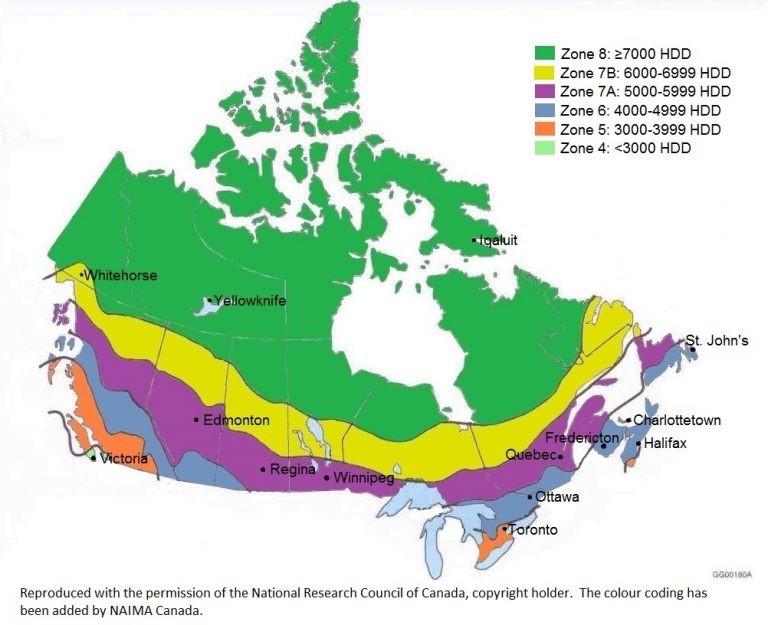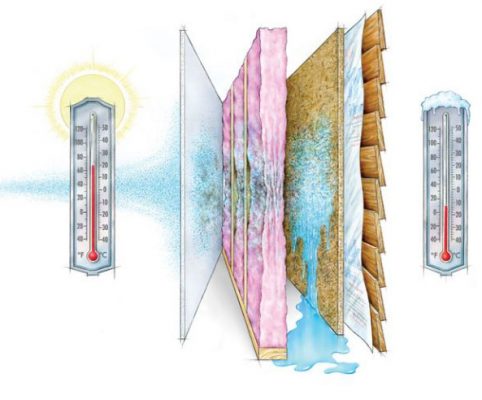♦This article is a refresh from one that Grant published on the Canadian Contractor, February 6, 2019.
A critical question impacting energy savings and indoor comfort is, “How ‘leaky’ is the building?” All buildings leak air, even the most energy efficient, air-tight ones do – to some degree. I’ve heard many times, “A building has to breathe”.
Buildings need to be ventilated, true, but this should be in a controlled manner by use of an air exchanger. A buildings wall assembly does not need to be ventilated, other than cladding systems. Buildings should not be constructed with an inferior air barrier that purposely allows air to flow through the envelope uncontrollably. Controlled ventilation through an air exchanger provides a durable, healthy, and energy efficient building. Let’s look at some important reasons why:
A leaky building envelope with a poor air barrier allows lots of air to filter through the building envelope via walls, roof, and floor. These building envelope components are comprised of dirty construction materials such as fiberglass insulation. Ever notice how insulation installers wear respirator masks? We should not be inviting the building’s fabric to filter the air we breathe.
Indoor air quality
1. A leaky building envelope with a poor air barrier allows lots of air to filter through the building envelope via walls, roof, and floor. These building envelope components are comprised of dirty construction materials such as fiberglass insulation. Ever notice how insulation installers wear respirator masks? We should not be inviting the building’s fabric to filter the air we breathe.
Energy performance
2. Air leakage also has a profound effect on the building’s energy performance. A super-insulated building with two foot insulated walls will not stay warm in winter if a window is open. The same analogy applies for an air-leaky building. Renown building scientist Dr. John Straube in his article PA-1203: Air Leaks – How They Waste Energy and Rot Houses (Staube, 2012), suggested that, “one-third of the energy you buy probably leaks through holes in your house”. Stack effect — the upward air pressures caused from the buoyancy of warm air — exasperates air leakage even further during the cold winter months when the temperature differential increases. Figure 1 illustrates the effects of air flows on an air leaky building caused by wind effect, stack effect, and typical combustion and ventilation systems.
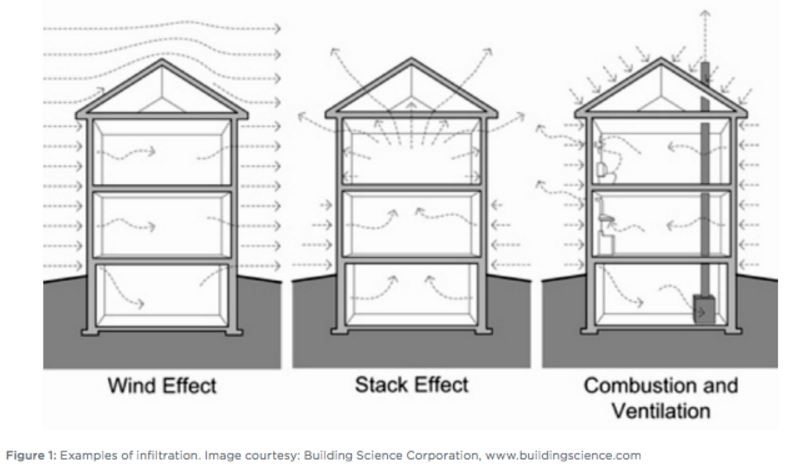
Indoor air quality
3. Buildings are full of air borne pollutants: carbon monoxide/dioxide, volatile organic compounds (VOCs), radon, mold, and other particulates. All these pollutants negatively affect indoor air quality (IAQ)*. That new home or new carpet smell may seem pleasant, but it’s in fact formaldehyde gases and other toxic VOCs. Even old furniture and other household materials continue to give off gas throughout their lifetime. Cooking, and heating with fossil fuels, can also heavily contribute to poor IAQ.
A useful measurement when screening for IAQ is carbon dioxide, measured in parts per million (ppm). The National Institute for Occupational Safety and Health (NIOSH) recommends the upper limit of good indoor air levels to be 600 ppm, with levels over 1000 ppm being linked to higher complaints of headaches, fatigue, and eye and throat irritation (Occupational Safety and Health Administration, 2016). “Carbon dioxide concentrations in closed or confined rooms can increase to 1000 ppm within 45 minutes of enclosure. For example, in a 11 ft x 13 ft sized office, atmospheric carbon dioxide increased from 500 ppm to over 1000 ppm within 45 minutes of ventilation cessation and closure of windows and doors” (Galera, 2016). The American Society of Heating, Refrigeration, and Air Conditioning Engineers (ASHRAE) recommends a continuous ventilation rate of 7.5 L/s/person (15 cfm/person) to maintain acceptable IAQ levels for a space with an activity level equivalent to an office building (ASHRAE, 2013). A study examining air quality and its relationship to better sleep and next-day alertness found that buildings with either poor or no ventilation routinely had indoor CO2 levels exceeding 2500 ppm. The study further found that sleep and next day performance, “can be significantly improved by increasing the clean outdoor air supply rate in bedrooms” (Strøm-Tejsen, 2016).
Energy performance, building durability, comfort, IAQ
4. Air doesn’t just carry heat; it also carries moisture. Typically, in summer air carries a lot of moisture (ie. humid), and in winter a little bit of moisture (ie. dry). Dry air infiltrating through the building fabric isn’t a huge concern, but it can be for moisture sensitive materials (like hardwood flooring) and for the occupants – refer to Figure 2 for optimum relative humidity. How about humid air? This is can be more of a concern. In addition to the same reasons that you don’t want excessively dry air, moist air can condense on the backside of vapour impermeable walls in air-conditioned buildings – like mirrors, vinyl wallpaper, and even cabinets. This occurs where moisture rich exterior air condenses on cool surfaces.
But wait, there’s more. The greater the interior moisture load (due to air leakage), the greater the latent load on the air conditioning equipment. But if the air conditioner has satisfied the sensible (temperature) load, then the conditioned space will be left cool but muggy – either requiring the air conditioner setpoint to be reduced further, or adding a dehumidifier to the mechanical system. The effect is exasperated further when you add: 1. reduced temperature loads due to improved thermal insulation and improved reflected solar energy due to low emissivity windows and/or improved shading, and 2. reduced latent to sensible cooling capacity ratios that is a result of higher “efficient” air-conditioning systems.
Building durability, comfort, IAQ
5. People inhabit buildings. Water vapour is produced by human activity — perspiration, breathing, cooking, showering, laundry — in surprisingly large amounts. It’s important this accumulation of water vapour be removed in order to control relative humidity (RH) levels, and to prevent mold growth and envelope deterioration.
An appropriate and safe RH level to maintain in a home is between 40 and 60 per cent. Figure 2 illustrates how bacteria, viruses, fungi, mites, allergic rhinitis and asthma, and chemical interactions increase as RH levels increase. At the same time, air pollutants increase when RH levels are on the low end. ASHRAE recommends 35 per cent interior RH in winter for best building envelope performance and IAQ in cold climates. This recommendation is slightly lower than the RH “optimum comfort zone” since it also reduces the risk of interstitial condensation occurring within the wall, which will increase building structure durability. In very cold and colder hygrothermal regions, 30% RH and even lower is recommended to maintain building durability.
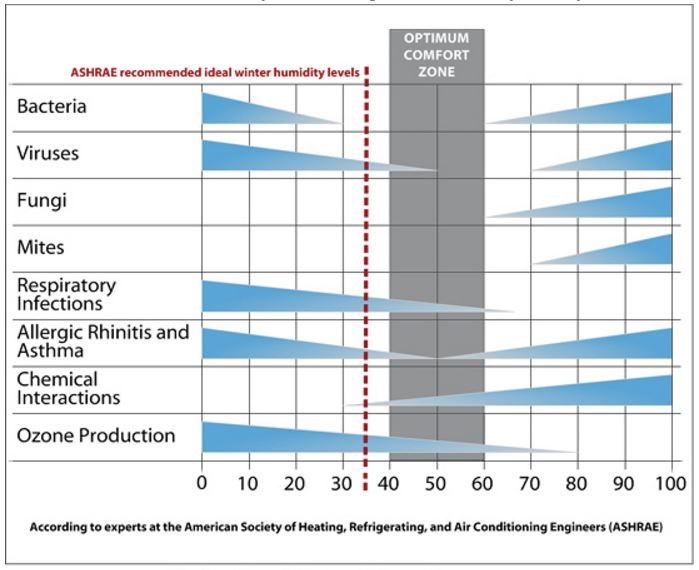
Controlled ventilation
Natural ventilation can of course be achieved by opening windows. This is easy and effective during the mild months or in mild climates without taking an energy penalty – don’t forget that the outdoor humidity level needs to be in an optimum range as well. But what about the other (majority of) times? A good solution is to install a controlled and balanced heat recovery ventilation system that takes stale inside air and exchanges it with fresh outside air. The systems that recover heat are called an HRV (Heat Recovery Ventilator), and ones that recovers heat and humidity are called an ERV (Energy Recovery Ventilator). Figure 3 illustrates the basic components of an HRV.
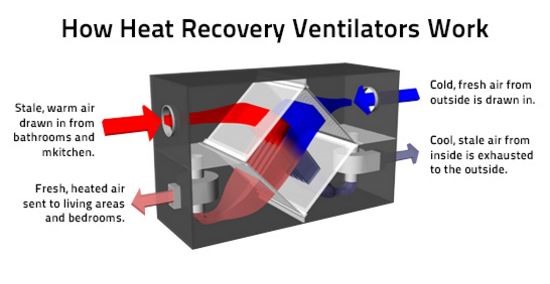
Other ventilation strategies that include exhaust-only or supply-only can result in large energy penalties, and should be only considered for buildings in mild climates – don’t forget about humidity. It’s no surprise that most building codes have mandated the use of HRV’s or ERV’s in new and renovation builds. Regardless of the ventilation strategies, however, exhaust-only vents should always still be provided at the kitchen range hood.
Building ventilation is very important to maintain a healthy and durable home. In an old, air-leaky building, an HRV may provide little value. However, the more airtight the building, the more important ventilation becomes.
References
- ASHRAE. (2013). Standard 62.1-2013: Ventilation for Acceptable Indoor Air Quality .
- Galera. (2016, 12 20). Problems and Solutions of Air Ventilation System. Retrieved from Course Hero
- Home Energy Program. (2016, 12 20). Stack Effect – Defined. Retrieved from Home Energy Conservation
- Minotair. (n.d.). Why Ventilate? Retrieved from Minotair The Science of Air


